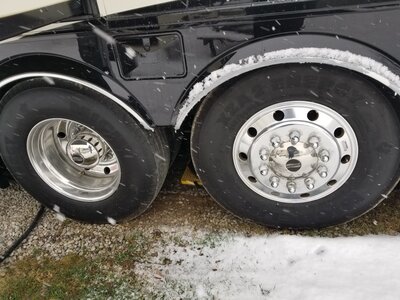Rd1
RVF Regular
- Joined
- Feb 16, 2022
- Messages
- 86
- RV Year
- 2017
- RV Make
- ̶N̶e̶w̶m̶a̶r̶
- RV Model
- ̶L̶A̶D̶P̶
- Chassis
- ̶F̶L̶
There is some misnomer relating to the use and application of nitrogen in tires. I have been using nitrogen in racing application for decades and it has its benefits. I did not use it in personal vehicles before.
Some 25yrs ago, I had a LF side wall tire blowout on a DP. The unit was only 3 yrs old. The following year had a sidewall blowout in the rear. That prompted me to lookinto the problem. It turns out some service stations do not maintain their compressors very well. Hence, a great deal of moisture is introduced into the tire when adding air. For most vehicles used regularly (daily), this may not be as big an issue. However, in an RV which maybe parked for very many months, it can be a problem.
The moisture collects in the bottom of the tire while parked for long periods of time. Over time, the moisture, like a cancer, eats into the side wall and impacts the sidewall. While driving, eventually, the tire may experience a blow, due to weakened sidewall.
Since that experience, I started using nitrogen and have had no blow outs. When I get a new unit, I do not replace the existing air with nitro. I just use the nitro to set the tire pressure, when needed. So no more moisture is added to the tire. That has worked very well.
In place of the $300 charge the OP has listed, I would consider buying (leasing) a nitrogen tank and just use it to add air when needed. Provided you have a place to store the tank.
It has been so long, I do not remember how much I paid for the original tank. However, the last time I had the tank replaced/refilled, the cost was $54 for a 2500psi, 4 foot tank. That was almost 2 years ago and I have a little less than 1000 pound left in it, so at least another year. There are a number of different outfits that sell/lease nitro tanks and usually ,you cannot interchange one with the other.
I use the tank to set tire pressure for the coach, trailer (tandem axle), car, truck, and even the tractor! So it gets used a lot, but it lasts a long time (3yrs). With a trailer in tow with the coach, the tank stays in the trailer. This option may not be for every one, but it has its utility.
You can zoom on the tire picture for the drive axle and you can see the thread is pretty low. This tire is the original for a unit about 7 yrs old and 75k miles. The coach/drive tire is also towing a 9k# trailer, so a great deal of extra load on the drive tire.
The coach has been outside in its entire life and exposed to temps of -15F all the way up to 100F. Gone x-country every year. A tire properly maintained and pressure set according to corner weight, that tire has a good chance to live its normal long life. The nitro has been an investment well worth its cost.
Some 25yrs ago, I had a LF side wall tire blowout on a DP. The unit was only 3 yrs old. The following year had a sidewall blowout in the rear. That prompted me to lookinto the problem. It turns out some service stations do not maintain their compressors very well. Hence, a great deal of moisture is introduced into the tire when adding air. For most vehicles used regularly (daily), this may not be as big an issue. However, in an RV which maybe parked for very many months, it can be a problem.
The moisture collects in the bottom of the tire while parked for long periods of time. Over time, the moisture, like a cancer, eats into the side wall and impacts the sidewall. While driving, eventually, the tire may experience a blow, due to weakened sidewall.
Since that experience, I started using nitrogen and have had no blow outs. When I get a new unit, I do not replace the existing air with nitro. I just use the nitro to set the tire pressure, when needed. So no more moisture is added to the tire. That has worked very well.
In place of the $300 charge the OP has listed, I would consider buying (leasing) a nitrogen tank and just use it to add air when needed. Provided you have a place to store the tank.
It has been so long, I do not remember how much I paid for the original tank. However, the last time I had the tank replaced/refilled, the cost was $54 for a 2500psi, 4 foot tank. That was almost 2 years ago and I have a little less than 1000 pound left in it, so at least another year. There are a number of different outfits that sell/lease nitro tanks and usually ,you cannot interchange one with the other.
I use the tank to set tire pressure for the coach, trailer (tandem axle), car, truck, and even the tractor! So it gets used a lot, but it lasts a long time (3yrs). With a trailer in tow with the coach, the tank stays in the trailer. This option may not be for every one, but it has its utility.
You can zoom on the tire picture for the drive axle and you can see the thread is pretty low. This tire is the original for a unit about 7 yrs old and 75k miles. The coach/drive tire is also towing a 9k# trailer, so a great deal of extra load on the drive tire.
The coach has been outside in its entire life and exposed to temps of -15F all the way up to 100F. Gone x-country every year. A tire properly maintained and pressure set according to corner weight, that tire has a good chance to live its normal long life. The nitro has been an investment well worth its cost.















